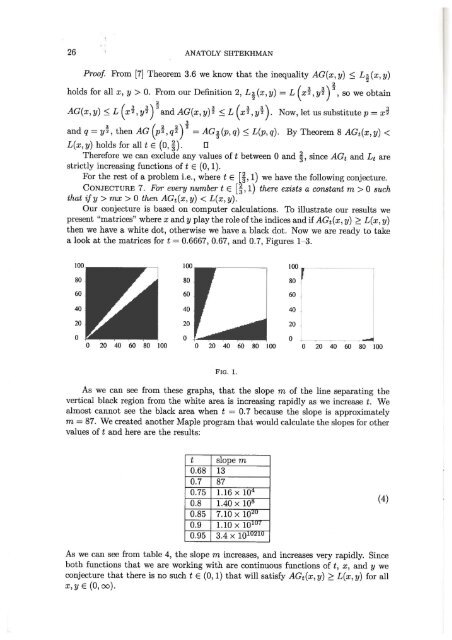Create successful ePaper yourself
Turn your PDF publications into a flip-book with our unique Google optimized e-Paper software.
26 ANATOLYSHTEKHMAN<br />
Proof. From [7] Theorem 3.6 we know that the inequality AG(x, y) ~ L:1 (x, y)<br />
2<br />
2<br />
holds for all x, y > 0. From our Definition 2, L~ (x, y) = L ( x~, y~) 3 , so we obtain<br />
2<br />
AG(x, y) ~ L ( x~, y~) 3 and AG(x, y)~ ~ L ( x~, y!). <strong>No</strong>w, let us substitute p = x ~<br />
and q = y~, then AG (pt,qt) ~ = AGf(p,q) ~ L(p,q). By Theorem 8 AGt(x,y) <<br />
L(x, y) holds for all t E (0, ~). 0<br />
Therefore we can exclude any values oft between 0 and ~'since ACt and Lt are<br />
strictly increasing functions oft E (0, 1 ).<br />
For the rest of a problem i.e., where t E [~, 1) we have the following conjecture.<br />
CONJECTURE 7. For every number t E [~, 1) there exists a constant m > 0 such<br />
that if y > mx > 0 then AGt(x, y) < L(x, y).<br />
Our conjecture is based on computer calculations. To illustrate our results we<br />
present "matrices" where x andy play the role of the indices and if AGt(x, y) 2: L(x, y)<br />
then we have a white dot, otherwise we have a black dot. <strong>No</strong>w we are ready to take<br />
a look at the matrices fort= 0.6667, 0.67, and 0.7, Figures 1- 3.<br />
100 100<br />
100 r<br />
80 80 80 ~<br />
ARITHMETIC-GEOMETRIC MEANS 27<br />
Acknowledgement. I want to dedicate this paper and say special thanks to Dr.<br />
Jakub Jasinski for all of his time, effort, help, and assistance during this research.<br />
REFERENCES<br />
[1] BECKENBACH, BELLMAN, E.F.R. "Inequalities", Springer-Verlag, Berlin-Heidelberg-New York,<br />
1961<br />
[2] BERRGREN, L., BORWEIN, J., AND BORWEIN, P., "II: a Source Book," Springer-Verlag Inc. New<br />
York 1997.<br />
[3] Cox, D.A., Gauss and the Arithmetic-Geometric Mean, <strong>No</strong>tices AMS, 32 (1985) 147-151.<br />
[4] OLMSTED, J.M.H., "Advanced Calculus", Prentice-Hall, Inc. Englewood Cliffs, N.J., 1961<br />
[5] SALAMIN, E., Computation of rr using Arithmetic-Geometric Mean, Mathematics of Computation,<br />
30 (1976) 565-570.<br />
[6] STEWART, JAMES, "Calculus", Brooks/Cole Publishing Company, 3-rd edition, 1995.<br />
[7] VAMANAMURTHY, M.K., VUORINEN , M. , Inequalities for Means, Journal of Mathematical Analysis<br />
and Applications, 183 (1994) 155-166.<br />
Anatoly Shtekhman, 539 Adams Ave, Scranton PA 18510.<br />
Anatoly Shtekhman is a native ofVinnitsa, Ukraine. In 1995 he moved to the U.S.<br />
where, in 1996, he became a math major at the University of Scranton. This paper<br />
is the result of a junior research project under the direction of Dr. Jakub Jasinski.<br />
60 60 60 ~<br />
40 40 40<br />
20 20 20<br />
0 0 0<br />
0 20 40 60 80 100 0 20 40 60 80 100 0 20 40 60 80 100<br />
FIG. 1.<br />
As we can see from these graphs, that the slope m of the line separating the<br />
vertical black region from the white area is increasing rapidly as we increase t. We<br />
almost cannot see the black area when t = 0. 7 because the slope is approximately<br />
m = 87. We created another Maple program that would calculate the slopes for other<br />
values oft and here are the results:<br />
t slope m<br />
0.68 13<br />
0.7 87<br />
0.75 1.16 X 10 4<br />
0.8 1.40 X lQM<br />
0.85 7.10 X 10 20<br />
0.9 1.10 X 10 107<br />
0.95 3.4 X 1010210<br />
As we can see from table 4, the slope m increases, and increases very rapidly. Since<br />
both functions that we are working with are continuous functions oft, x, andy we<br />
conjecture that there is no such t E (0, 1) that will satisfy AGt(x, y) 2: L(x, y) for all<br />
x, y E (0, oo).<br />
(4)<br />
A <strong>No</strong>te on Infinite Harmony.<br />
2:::-:-=00<br />
'l<br />
i=1<br />
n 1<br />
The divergence of the Harmonic Series may be considered a "classic" among the<br />
basic results of calculus. There are many different proofs of this fact and it might be<br />
a nice exercise for students to find their own proofs before looking up the standard<br />
proof in the their Calculus Book. Here is a proof by ANDREW CUSUMANO of Great<br />
Neck, New York:<br />
We start with the observation that<br />
1 1 2x 2<br />
x - c + x + c = x 2 - c2 > ;;<br />
from which we easily deduce that the sum of any string of 2k + 1 terms of the harmoni<br />
series centered about 1/(2k + 1) is<br />
The following 3(2k + 1) = 2(3k + 1) + 1 terms will be centered about the term<br />
1 1<br />
~----~~----~ = -------<br />
(3k+2)+(3k+l) 3(2k+l)<br />
and so will also sum up to a number greater than 1, and so on. It follows immediately<br />
that the harmonic series diverges.<br />
The asymptotics of these estimates could be investigated.
















